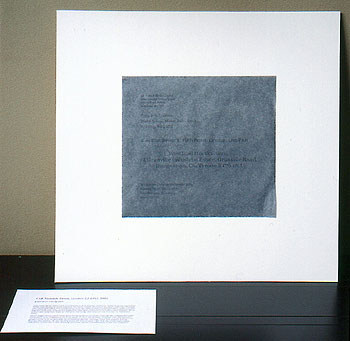
 |
Jacqueline Jeffries + Rob Kemp
Recently I have been looking at pictorial representations of rocks and the landscape through photographs or illustrations in contemporary geological reference books, historical drawings and/or objects collected by myself. My selection of source material is, in part, intuitive but often preference is made for objects or images that are ambiguous or slight in appearance - the minute rather than the monumental. My own drawing becomes the structure that ties together the different sources within a single style of drawing.
The drawing on page 12, made for the Landing work-in-progress exhibition, was in response to Rob Kemp's academic research as a soil scientist. What impressed me most was how his work reveals the extent to which external influences can continually affect soil composition. It is very easy to assume that the earth under our feet is something constant - something that was 'fixed' a very long time ago. The methodologies that soil scientists employ are adapted to each given situation to produce their analysis. As an artist I also seek new ways to interpret the things that interest me in order to represent them.
Since I began this project I have been thinking about my small urban garden in Bethnal Green. Here there is no indigenous earth to speak of, as it has all been covered over. All the soil I use has been imported in bags purchased at a garden centre. This makes me think about my garden more as an artifice than as something natural. I wonder how soil analysis would express this artifice. As my starting point for this project, I felt that the most measurable references I could use in this drawing were the names and addresses of the soil suppliers.
After this drawing was shown in the display case, I was interested in finding out more about Rob Kemp's work. This piece entitled 'Micromorphology of loess-paleosol sequences: a record of paleoenvironmental change' is a response to an article he wrote and a reflection on the stylistic conventions and format of academic journals and questions of scientific knowledge. Its title, diagram and text borrow from Kemp's paper of the same name which appeared in Catena in 1999.
Science seeks to fill in gaps in knowledge. Diagrams aim to express something that is otherwise too complex to be meaningful, but the diagrams themselves can easily become merely abstractions. Remove the key to their reading and they become meaningless. My interests are in what remains unknown and unfixed, what is lost and what is shown in the abstraction of complex data in the form of a diagram or text - the gaps between particles in a soil sample or pebbles on a beach. This artwork is a further abstraction that alludes to but deletes the context of the diagram and sentence. The spaces around them that were filled with words as they first appeared, remain empty here.
This art work explores the notion of both the exact and the approximate. The approximate - the more unknown element - is the point of access to imagination and creative thought. The title of the artwork is therefore as important as the work itself. One does not function without the other. It suggests a theoretical context and an academic engagement with a body of knowledge which in this case remains unknown, elusive.
Jacqueline Jeffries